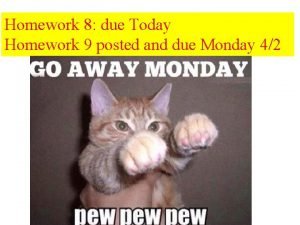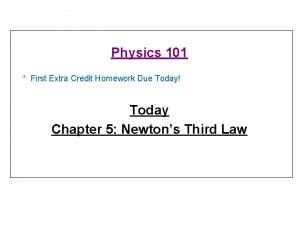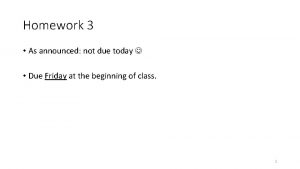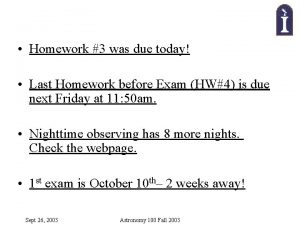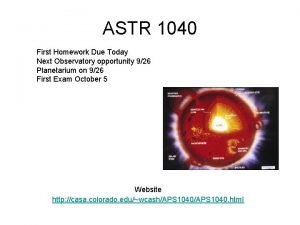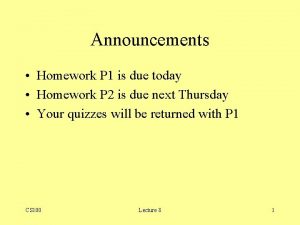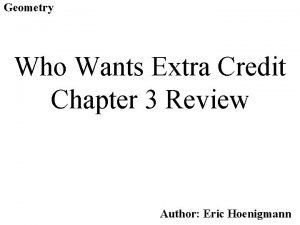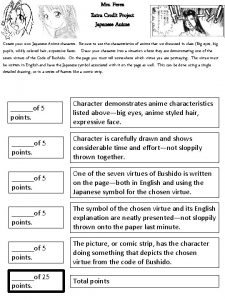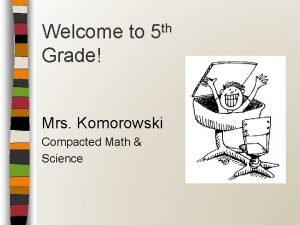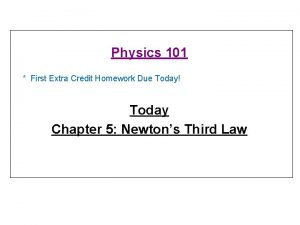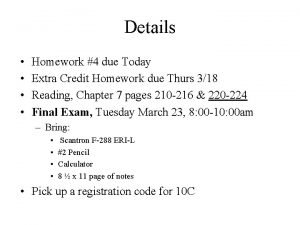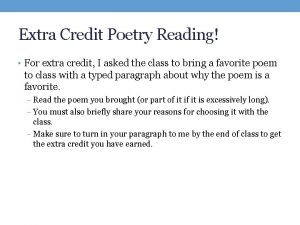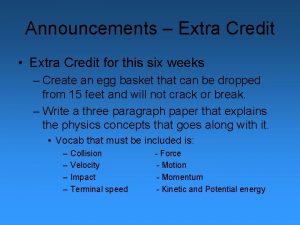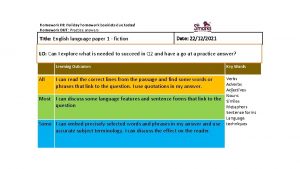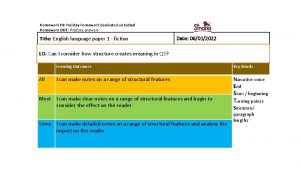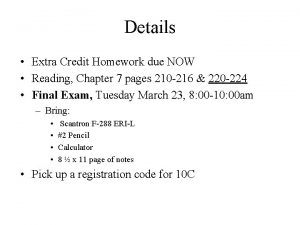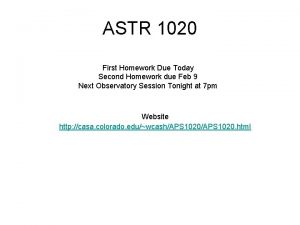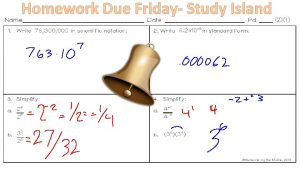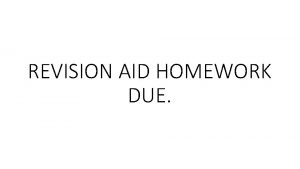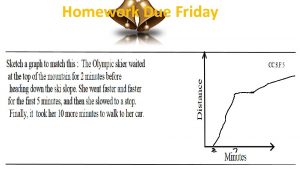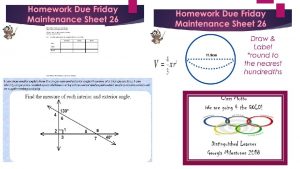Physics 101 First Extra Credit Homework Due Today























- Slides: 23

Physics 101 * First Extra Credit Homework Due Today! Today Chapter 5: Newton’s Third Law

First, let’s clarify notion of a force: Previously defined force as a push or pull. Better to think of force as an interaction between two objects. Eg. I push on the table, it pushes back on me with an equal and opposite force on me. If on ice (no friction), I’d slide backwards. This force pair constitutes a single interaction. (More examples very soon) You can’t push anything without it pushing back on you ! Whenever one object exerts a force on a second object, the second object exerts an equal and opposite force on the first. Newton’s 3 rd Law - often called “action-reaction”

Eg. Leaning against a wall. You push against the wall. The wall is also pushing on you, equally hard – normal/support force. Now place a piece of paper between the wall and hand. Push on it – it doesn’t accelerate must be zero net force. The wall is pushing equally as hard (normal force) on the paper in the opposite direction to your hand, resulting in zero Fnet. This is more evident when hold a balloon against the wall – it is squashed on both sides.

Eg. You pull on a cart. It accelerates. The cart pulls back on you (you feel the rope get tighter). Can call your pull the “action” and cart’s pull the “reaction”. Or, the other way around. • Newton’s 3 rd law means that forces always come in action -reaction pairs. It doesn’t matter which is called the action and which is called the reaction. • Note: Action-reaction pairs never act on the same object

Examples of action-reaction force pairs In fact it is the road’s push that makes the car go forward. Same when we walk – push back on floor, floor pushes us forward. (These forces are frictional). Demo: blow up a balloon and release it. Same principle as rocket

Clicker Question What is the reaction force to a bat striking a ball? A) the ball’s hit on the bat B) the muscular effort in the player’s arm C) the friction force between the ground and the player’s feet D) gravity E) None of these Answer: A Note that we could call either the action and the other the reaction – it doesn’t matter which one is which.

Another Question What are the action-reaction pairs once the ball is in the air? First note there are two interactions: (i) one with the earth’s gravity and (ii) the other with the air. (i) Action (or reaction): Earth pulls down on ball (weight) Reaction (or action): Ball pulls up on Earth. (ii) Action: Air pushes ball backwards (air resistance) Reaction: Ball pushes air forwards

Clicker Question We just said that for a ball in the air, an action-reaction pair is Earth’s gravity acting on the ball, and the ball pulling the Earth up. Which force is bigger? A) The Earth’s gravity acting on the ball B) The Ball pulling the Earth up C) They have the same strength

Clicker Question We just said that for a ball in the air, an action-reaction pair is Earth’s gravity acting on the ball, and the ball pulling the Earth up. Which force is bigger? A) The Earth’s gravity acting on the ball B) The Ball pulling the Earth up C) They have the same strength Action and reaction pairs are always equal and opposite in direction. Again, remember to distinguish the force from the effect of the force – the Earth’s acceleration under the interaction with the ball is much smaller than that of the ball, because Earth’s mass is much larger and a = F/m. (More shortly…)

Another Clicker Question Since action and reaction are equal and opposite, why don’t they cancel to give zero effect? A) They do! B) They do if the masses of the objects are the same, otherwise they don’t C) They act on different objects. Answer C: They act on different objects. If you define the “system” to be both objects, then actionreaction forces within the system do cancel. Let’s explore this a bit more…

Let’s consider the force pair between the “apple” and “orange” below: F F Apple exerts a force F on orange, so orange accelerates. Simultaneously, orange exerts equal force in the opposite dir. on the apple (but apple may not accelerate because of friction on his feet). friction Consider now orange as the “system”. Apple’s pull on orange, F, is an external force and accelerates the system(=orange) to the right. F Consider now the apple+orange as one system. Then the only external force is friction. Action and reaction are both within the system and cancel to zero. friction If friction =0, the acc. of system =0 (eg if they were on ice). Apple and orange would move closer to each other but system’s center of mass wouldn’t move. System accelerates to the right.

Questions (1) A pen at rest. It is made up of millions of molecules, all pulling on each other - cohesive inter-atomic forces present in any solid. Why doesn’t the pen accelerate spontaneously due to these forces? Because each of these is part of an action-reaction pair within the pen. They always add to zero within the system. The pen will remain at rest unless an external force acts on it. (2) The earth’s gravity pulls on the moon. What is the reaction force to this? Ans: The moon’s pull on the earth. Note: It is simpler to think of this as one interaction – the Earth and moon simultaneously pull on each other (action-reaction), each with the same amount of gravitational force. (3) Consider for simplicity, the earth and moon as the only bodies in the universe. a) What is the net force on the earth? The moon’s gravitational pull b) What is the net force on the earth+moon system? 0. Action and reaction cancel within the system

More on action-reaction… • If all forces come in pairs, then how come the earth doesn’t accelerate towards apples falling from trees? Actually it does! But it is noticeable or measurable because the earth’s mass is so large (c. f. earlier clicker question): mass of apple The earth exerts force = mg on the apple. This interaction gives apple acc = F/m = 9. 8 m/s 2. The apple exerts just as much force on the earth, mg. But to get acc of earth, this gets divided by M, the mass of the earth: earth’s acc. = (mg)/M ~ tiny.

And more on action-reaction… • E. g. A skater pushes another and recoils The force exerted on the woman is just as large as the reaction force on the man, so he also moves backwards. But his acceleration is lower since his mass is larger. • E. g. “Kick”, or recoil, of a fired rifle: abullet = F/mbullet arifle=F/mrifle • Same Since mrifle >> mbullet, but same F, arifle<< abullet principle behind a rocket (or earlier balloon demo) – it continually recoils from the ejected gas.

Clicker Question A 1900 newspaper editorial stated it is impossible to launch a rocket above the Earth’s atmosphere. Do you agree? A) Yes, rockets need an atmosphere to push against. B) No, it propels forward under reaction force to the action of rocket expelling the exhaust gases. C) Yes, there needs to be a certain atmospheric pressure since a balance between pushing against the atmosphere and air-drag is required. Answer: B Just like the balloon demo, or rifle recoil. The reaction to exhaust gases does not depend on a medium for the gases. In fact, in a vacuum there is no air drag and rocket operates even better.

Summary of Newton’s Three Laws • An object tends to remain at rest, or, if moving, to continue moving at constant speed in a straight line (1 st Law). Objects tend to resist changes in motion (inertia) – mass measures this. • (2 nd Law) When there is a net force on an object, it will accelerate: a = Fnet/m, a is in the same direction as Fnet. • Falling in vacuum (free-fall), the only force is gravity, mg, and every object falls at the same rate, g =9. 8 m/s 2 • Falling in air, Fnet = mg – R, acceleration is less than g. R is greater for objects with more frontal area, and for larger speeds. Terminal speed is reached when R = mg, so is later for heavier objects, which therefore accelerate more and hit ground faster. • (3 rd Law) Whenever any object A exerts force on object B, B exerts equal and opposite force on A. It is a single interaction, forces come in pairs. Action and reaction always act on different objects.

Vectors • Vector = quantity with magnitude and direction, eg velocity, force, acceleration…. Can represent by an arrow (length indicates magnitude) • Scalar - has magnitude only, eg speed, mass, volume. . Often we want to add vectors: eg if want to find net force, when several forces acting, or, to find resulting velocity when a plane is headed in a certain direction, but there is a wind blowing in another. . • • If the two vectors are in the same direction – can just add. If in opposite directions, subtract. + =

More generally, use parallellogram rule to add to get the resultant: construct such that two adjacent sides are the two vectors – the diagonal shows the resultant. Simplest case: when the two vectors to be added are at right angles: The parallelogram is a rectangle in this case. • When the two vectors are at right-angles and have the same magnitude, then the parallelogram is a square: • Pythagorean triples can also simplify addition: eg. Top view of 30 N and 40 N horizontal forces pulling on a box, gives a resultant force of 50 N in direction shown: • Vector components: “resolve” any vector into two components at right-angles to each other. We won’t study this in this course, but do read about it in your book if you are interested!

Example The girl is hanging, at rest, from a clothes line. Which side of the line is more likely to break? First, identify forces: Three forces are acting on her – downward weight, tension in left line, and tension in right line. The question is asking, which tension is greater. Because she’s at rest, the net force must be 0. The upward tensions must sum to her weight. Make parallelogram with sides along the rope tensions, whose diagonal is the desired upward resultant: So, larger tension in the right line (more vertical), so it is more likely to break.

Clicker Question Hint: note, this is asking a “time” question, not a “where” question.

Answer: b, the one headed straight across, since the velocity of the motor is entirely straight across, not “wasted” by going up or down the river. Note that it will end up downstream. Another question: Which boat provides the fastest ride? Answer: c, because it has the largest resultant velocity vector (sketch the parallelograms to see) Yet another question: Which boat ends up straight across from where it started? Answer: a, the resultant velocity vector is straight across, perpendicular to the current.

Example Hint: first, draw a sketch showing the forces acting on the book. These should sum to the net force on the book - what should this net force be?

Answer: 3. can’t say If she barely pushes the book so that the vertical component of her push is less than the book’s weight, then friction acts upward to keep the book stationary. If she pushes so that the vertical component of her push equals the book’s weight, then there’s zero wall friction on the book. If she pushes harder so that the vertical component of her push exceeds the book’s weight, then friction acts downward. So unless we know how the vertical component of her push compares with the weight of the book, we can’t specify the direction of friction between the book and the wall.
 This can be avoided by giving credit where credit is due.
This can be avoided by giving credit where credit is due. Folk culture and popular culture venn diagram
Folk culture and popular culture venn diagram Black cat analogy
Black cat analogy Homework due today
Homework due today Homework
Homework Iron core
Iron core Homework due today
Homework due today Homework due today
Homework due today Extra credit chapter 3
Extra credit chapter 3 Extra credit anime
Extra credit anime Extra credit
Extra credit Extra credit avance
Extra credit avance How to ask for extra credit
How to ask for extra credit How to write an email to a teacher about homework
How to write an email to a teacher about homework Extra credit chapter 15
Extra credit chapter 15 Homework oh homework
Homework oh homework Homework oh homework i hate you you stink
Homework oh homework i hate you you stink Jack prelutsky homework oh homework
Jack prelutsky homework oh homework Oh homework oh homework poem
Oh homework oh homework poem Alitteration definition
Alitteration definition When she sings her voice is like velvet
When she sings her voice is like velvet ______ you finish your homework yesterday?
______ you finish your homework yesterday? For todays meeting
For todays meeting Have a class today
Have a class today


